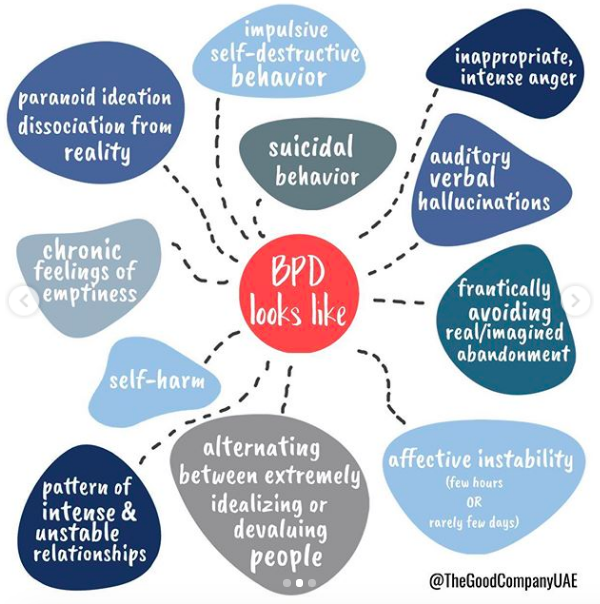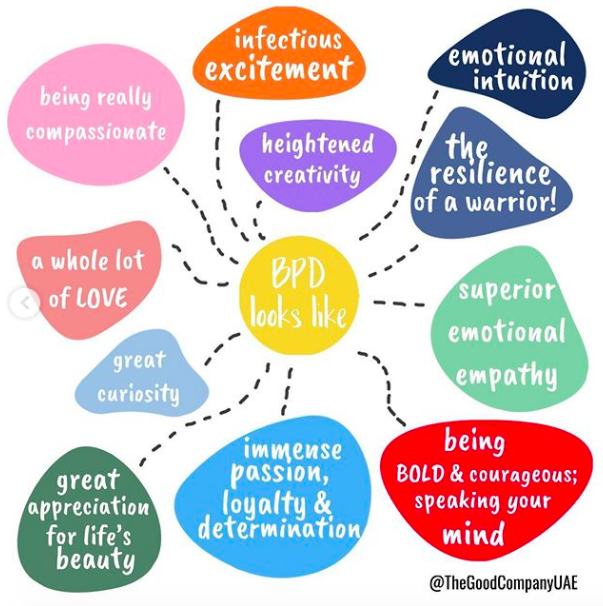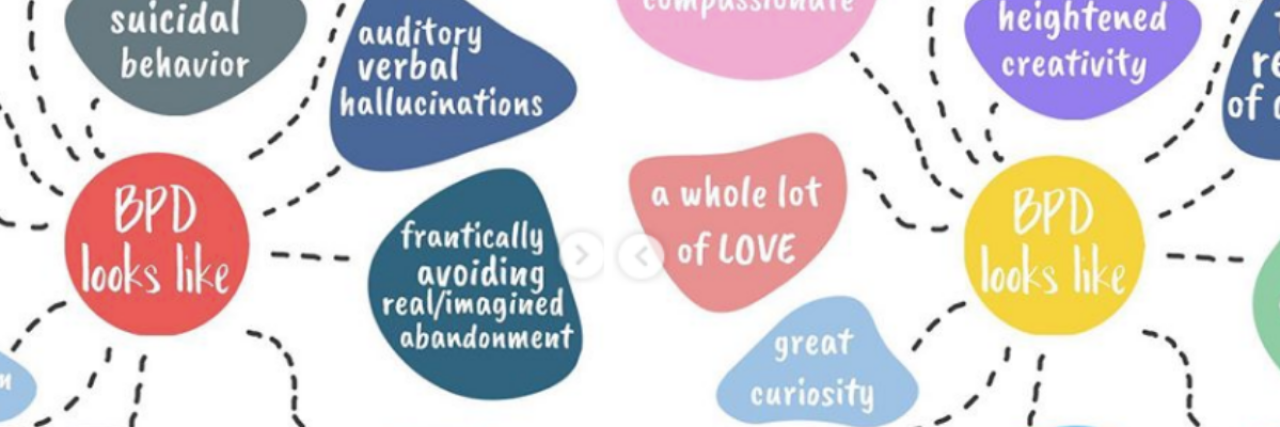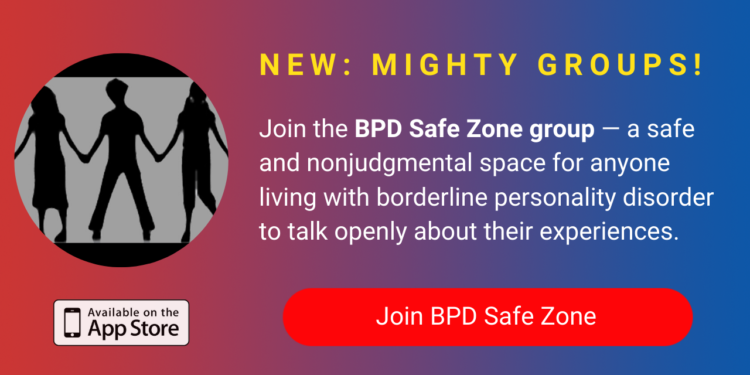The Good Company UAE, a mental health cyber space focused on providing free support during the COVID-19 outbreak, recently surfaced a borderline personality disorder (BPD) two-part graphic on their Instagram account. The graphic depicts a list of main symptoms, but the second part also includes some less commonly discussed yet central strength-based qualities. It has prompted a needed conversation about all parts of living with BPD.
BPD is a complex, often misunderstood and highly stigmatized mental disorder characterized by emotion dysregulation and extreme emotional hypersensitivity. People with BPD tend to experience intense emotional reactivity for long periods of time, with a slow return to a stable emotional baseline.

Image description: The middle red circle says, “BPD looks like,” with the main symptoms branching off of that middle circle: Chronic feelings of emptiness, paranoid ideation, dissociation from reality, impulsive self-destructive behaviors, intense anger, auditory verbal hallucinations, frantically avoiding real/imagined abandonment, affective instability (few hours or few days), alternating between extremely idealizing or devaluating people, pattern of intense & unstable relationships, and self-harm. The main symptoms are circled in shades of blue and grey.

Image description: The middle yellow circle says, “BPD looks like,” with some strengths branching off of that middle circle: A whole lot of love, being really compassionate, infectious excitement, heightened creativity, emotional intuition, the resilience of a warrior, superior emotional empathy, being bold and courageous; speaking your mind, immense passion, loyalty, and determination, great appreciation for life’s beauty, and great curiosity. The strengths are circled in shades of yellow, pink, blue, green, and orange.
Living with the symptoms of BPD impacts multiple contexts of my life. My baseline emptiness feels like a perpetual, freshly wounded heartache — parallel to feelings of grief and loss. Only, this feeling is just another morning with BPD. The intense emotions are like sorrow instead of sadness, and shame and humiliation instead of embarrassment. Perceived slights may implode hurt and anger. Misunderstandings may provoke paranoid ideation, where we perceive threats and plots to abandon or hurt us, or less often, paranoid delusions.
Especially, people with BPD may have extreme reactions to mundane events in which abandonment or rejection can be perceived, such as brief separations at work or errands. We may perceive social information as negatively biased.
The graphic also includes stress-induced transient dissociation or hallucinations, significant yet often ignored parts of living with BPD.
With the intense struggles of BPD, it can be hard to practice self-compassion and grasp any strength-based qualities within ourselves. Struggling with a sense of self, we may view ourselves as entirely “bad,” deserving of pain and use bodily self-injury or substances to cope or as punishment. As someone with borderline personality disorder, I sometimes struggle to see anything “good” about myself at all.
Yet, it is essential to practice self-compassion and recollect that we are whole human beings with inherent value and strengths. The graphic depicts a starting point for a fuller perspective — it includes the wholeness of living with the intensity of BPD. Side by side, the symptoms and strengths are not viewed as mutually exclusive experiences and do not alienate or disparage the existence of the other. The coloring of the graphics also seems to be with intent. It is a commendable and validating representation of BPD that includes a multitude of parts and experiences.
It is not to say BPD should be romanticized — that is, portrayed as fanciful, glamorous or lighthearted. For example, romanticizing may portray BPD as an aspiration, coveted personality trait or an aesthetic. The pain and symptoms we experience are very real and debilitating. Romanticizing may also worsen public outlooks, given that it encompasses a glamorous, lighthearted and overly simplified representation. To latch onto romanticization of BPD means to overlook the struggle and the person for who they really are outside of a fixed, simplified image.
Likewise, forcing an “overly positive” representation can feel invalidating and alienate those of us who struggle with symptoms that are more heavily stigmatized, including outbursts of anger, repeated self-injury, hallucinations, and impulsivity.
Rather, a fuller picture of BPD can be talked about while honoring the complexity of experiences, which can include strengths.
In addition to the heightened negative emotions, we may experience heightened positive emotions. Happiness in BPD can be better described as intense elation, euphoria or idealization. Sometimes, the extremity of BPD seems like only one emotion and moment exist at a time. When I am hurt, it seems the pain overrides any positive emotion or event that has ever happened in my life. When I am elevated or idealizing, I “forget” what I may have been crying about only a few minutes ago. Like the abandonment fears, we may have difficulty maintaining emotional constancy as if emotions, experiences and people only “exist” when they are present.
For me, idealization can benefit relationships if channeled suitably. I have been repeatedly described by friends as a thoughtful person. I choose to foster my relationships, and I love thinking about the other person in a positive light. I tend to form strong attachments. The people in my life and their happiness, their thoughts, and life events deeply matter to me. Whether expressed through words, gifts or being deeply considerate, I make it a point to show the other person what my thoughts and feelings are about them. I have so much love to give.
I have also been described by numerous classmates and colleagues as reflecting infectious energy and excitement — I act with a sense of urgency and passion. Being around people can magnify and spread the elation. I can talk for hours about topics I am passionate about and lighten up at the slightest mention of them.
Similarly, according to Dr. Marsha Linehan, on the positive side, people with BPD are, “…idealistic and likely to fall in love at the drop of a hat. They may experience joy more easily, and thus may also be more susceptible to spiritual experience.”
Intense emotions can be channeled and redirected. I can listen to and use that energy for my intention. I could be soaring a million miles through anger attacks or euphoria enamored by life and sensation.
My career revolves around social justice issues, psychology and mental health, all of which I am profoundly passionate about. I speak my mind and have a vigorous sense of right and wrong. I am distinctly curious and hungry for knowledge. Learning to me is never just another question or class, just another book or just another paper. It is access to knowledge, perspective, life and futures. It is opportunity and a tool for creativity driven by emotion and intuition.
Every second spent in the ER and hospital, therapy, medication trial, and every second of stigma, pain and grief has touched my life in a way that motivates change. Change not just within myself, but it fuels my life and determination. It has called me and my heart, to where I am today. I am empathetic and strive for authenticity and am not hesitant to show it.
Living with BPD can be like trying to balance an emotional light switch between on and off. But holding onto the existence of positive qualities and experiences, even if they feel so distant, has helped me stay grounded and maintain a balanced, fuller perspective of my life and who I am.
To people with BPD who struggle to see anything good about yourself as I have, hopefully this discussion serves as a reminder of your inherent worth and strengths. Those of us with BPD should be encouraged to channel some strengths we may find related to BPD, such as intense emotions, which are not “bad” in every context.
For further reading on the topic, check out this article that includes a compilation of positives and strengths from The Mighty BPD community.
Here is an additional list of dialectical behavior therapy skills that have been helpful for when I struggle with a negative sense of self.
- First, check the facts is a skill that reminds us to evaluate the situation before acting on an emotion. If I feel like I am “all bad,” I might deliberately step back and evaluate whether or not my emotion fits the situation. Maybe I can make a list of good qualities about myself or good things I have done, which contradict negative views of myself and maintain a balanced perspective.
- Self-validation could involve statements acknowledging how I feel and understanding why I feel that way, self-encouragement, and acknowledging your strengths like this graphic.
- Opposite action may then be a helpful skill to “act opposite” of that feeling. When I view myself as bad, I might have self-injury urges or isolate myself. Instead of self-injury, I could assess my current needs and take care of myself. Do I need rest? Food? Self-care? Instead of isolating, I could connect with a friend, which can alleviate some feelings of isolation instead of preserving them.
Community members with borderline personality disorder: tell us about some of your good quality traits in the comments below!
Image via The Good Company UAE


